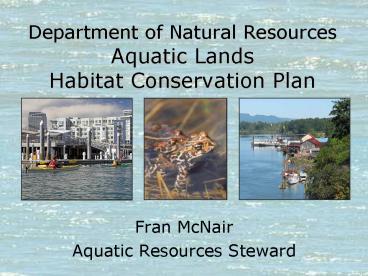Department of Natural Resources Aquatic Lands Habitat Conservation Plan - PowerPoint PPT Presentation
1 / 32
Title:
Department of Natural Resources Aquatic Lands Habitat Conservation Plan
Description:
Southern resident killer whale. Columbia spotted frog. Sockeye salmon ... Aquaculture (fin fish and shellfish) Which activities are covered in this HCP? ... – PowerPoint PPT presentation
Number of Views:47
Avg rating:3.0/5.0
Title: Department of Natural Resources Aquatic Lands Habitat Conservation Plan
1
Department of Natural Resources Aquatic Lands
Habitat Conservation Plan
- Fran McNair
- Aquatic Resources Steward
2
- DNR applauds the Legislatures strong support of
efforts to restore Puget Sound, particularly in
establishing the Puget Sound Partnership.
3
- Puget Sound is our states most notable water
resource,
but aquatic habitats throughout our state need
protection.
4
While the Partnership spends this year evaluating
what is needed to restore Puget Sound
DNR already has a plan.
5
DNR already has a plan
- DNRs Aquatic Lands Habitat Conservation Plan
(HCP) will protect endangered species and their
habitats in the Sound and throughout Washington.
6
DNR is ready to put this plan into action
- With Legislative support, DNR can begin putting
the Aquatic Lands HCP into action
a definitive step in restoring the balance
between a healthy ecosystem
and a healthy economy throughout Washington state.
7
Why are we doing the Aquatic Lands HCP?
- It is DNRs job to strike a workable balance
between species conservation and private land use
on Washingtons aquatic lands.
8
Why are we doing the Aquatic Lands HCP?
- Thats why DNR voluntarily undertook the task of
developing the nations most comprehensive
Aquatic Lands HCP.
9
Why are we doing the Aquatic Lands HCP?
- The Aquatic Lands HCP examines the
interrelationship among aquatic species,
aquatic habitats, and
activities that
could harm them.
10
Why are we doing the Aquatic Lands HCP?
The Aquatic Lands HCP offers a consistent and
efficient approach that will
help DNR protect aquatic species and habitats
while allowing approved activities on state-owned
aquatic lands.
help other departments fulfill their mandates by
sharing information.
11
DNR is working with the support of federal
agencies
- Since starting work on our Aquatic Lands HCP, we
have received guidance and monetary support from
the U.S. Fish and Wildlife Service and the
National Marine Fisheries Service.
12
These federal agencies are invested in DNRs
success
- The U.S. Fish and Wildlife Service and the
National Marine Fisheries Service have already
provided 2,000,000 to develop this Aquatic Lands
HCP.
13
Federal agencies implement the Endangered Species
Act
- The U.S. Fish and Wildlife Service and the
National Marine Fisheries Service support DNRs
work because we are helping them implement the
Endangered Species Act.
14
The goal of the Endangered Species Act
- The ESA strives to
protect and recover imperiled species and the
ecosystems they depend on so they no longer need
protection under the ESA while allowing for
growth and development in a sustainable way.
15
Which species are covered in this HCP?
- Determining which species should be included in
this HCP is the core of DNRs work to date.
16
Which species are covered in this HCP?
- The ESA Team
- Gathered information about the habitats and
occurrence of aquatic plants and animals,
Paid close attention to each species dependence
on submerged habitats and
Examined how each might be negatively affected by
activities that take place on state-owned aquatic
lands.
17
Which species are covered in this HCP?
- The ESA Team identified 22 species that are
covered in the ESA as the focus of DNRs Aquatic
Lands HCP.
18
Which species are covered in this HCP?
19
Which habitats are covered in this HCP?
- The Aquatic Lands HCP covers most state-owned
aquatic land located under marine, estuarine, and
fresh waters of the state.
20
Which activities are covered in this HCP?
- Overwater structures (docks, boat ramps, mooring
buoys, floating homes)
21
Which activities are covered in this HCP?
Complex structures (marinas, shipyards, terminals)
22
Which activities are covered in this HCP?
Aquaculture (fin fish and shellfish)
23
Which activities are covered in this HCP?
Log booming and storage
24
Which activities are covered in this HCP?
- These activities were selected because they occur
on state-owned aquatic land
and DNR authorizes or carries them out.
25
Which activities are covered in this HCP?
- These activities are not covered by other
compliance or management plans
and can cause significant harm to ESA-covered
species.
26
Which activities are covered in this HCP?
- The Aquatic Lands HCP identifies conservation
measures to avoid,
minimize,
or
mitigate
impacts to ESA-covered species from covered
activities.
27
Conservation measures are identified in this HCP
- Minimize structural shading,
such as replacing wood planking on a dock with
metal mesh that allows sunlight to reach the land
beneath the dock.
28
Conservation measures are identified in this HCP
- Reduce inputs of chemicals and debris,
such as requiring recreational dock owners to
replace docks built with treated lumber and
flotation devices like Styrofoam with less
harmful materials.
29
Conservation measures are identified in this HCP
- Remove derelict structures,
so they dont continue to pose a danger to people
or aquatic species.
30
We need your help to put this plan into action
- Implementing this HCP will require the
Legislatures support so DNR can ask for
compliance from the public.
31
We need your help to put this plan into action
- Implementing the Aquatic Lands HCP will also
require dedicated funding to
Coordinate with multiple stakeholders, agencies,
and tribal governments.
Collect and assess new information so we can
adapt our management approach according to real
conditions in the field.
32
DNRs Aquatic Lands HCP is timely and
comprehensive
This HCP will protect aquatic species and their
habitats,
while still allowing responsible uses of
state-owned aquatic lands.
Your support will make a world of difference.
Thank you.































